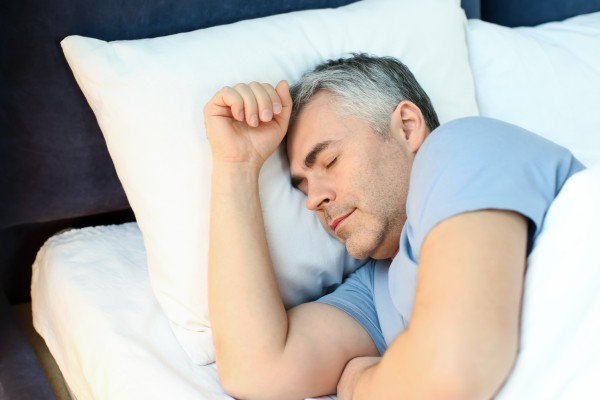Blog
Rest Easy: Diagnosing & Treating Sleep Apnea

What does a typical morning look like for you? Do you wake up feeling rested, recharged, and ready to conquer the day? Or do you feel as though you must drag yourself into your daily routine propped by exorbitant — and frankly, unhealthy — amounts of caffeine? A good night’s sleep is imperative to maintaining your physical and mental health, but sleeping disorders like sleep apnea can prevent your body from getting the rest it needs. As one of the most common conditions, sleep apnea is often misunderstood yet easily treatable, leading to more restful nights and energetic, healthier days.
What Is Sleep Apnea?
Sleep apnea is more than just loud snoring. Characterized by periodic or sporadic gasping or snorting sounds that interrupt sleep, sleep apnea is defined as the interruption and restarting of breathing, according to the Centers for Disease Control. Those suffering from sleep apnea may go through their days drowsy and in a fog, but it can also prevent the body from getting enough oxygen, according to the National Heart, Lung, and Blood Institute. Sleep apnea is classified as two types:
Obstructive sleep apnea occurs when the upper airway becomes blocked periodically throughout the night, consequently reducing or stopping airflow. According to the Sleep Foundation, this is the most common form of sleep apnea, affecting 10-30% of adults in the United States. Obstructive sleep apnea may be caused by obesity, large tonsils, and changes in hormone levels with symptoms including:
- Excessive daytime sleepiness
- Loud snoring with gasping or choking sounds
- Headaches beginning early in the day and lasting several hours
- Dry mouth when waking
- Restless sleep
- Increase need to get up and urinate at night
- Irritability or frustration during the day
- Lack of focus
Central sleep apnea occurs when the brain fails to send signals controlling the body’s ability to breathe, including managing airways and chest muscles. Central sleep apnea may be caused by numerous conditions affecting the brain’s communication with the body, including heart failure, stroke, amyotrophic lateral sclerosis (ALS) or Lou Gehrig’s disease, myasthenia gravis, premature birth if pregnant, or opioid use. Symptoms include:
- Abnormal breathing patterns
- Excessive daytime sleepiness
- Awakening at night
- Sudden shortness of breath or chest pains at night
- Lack of focus
- Morning headaches
Because both forms of sleep apnea negatively impact sleep quality and oxygen levels, the disorder has been linked to numerous health risks, including:
- Increased risk of car accidents due to drowsy driving
- Cardiovascular diseases like hypertension, stroke, heart failure, heart disease, and arrhythmia (abnormal heartbeat)
- Metabolic disorders like type 2 diabetes
- Pulmonary hypertension
- Mental problems like impaired memory and concentration
- Irritability
- Higher risk of depression
- Nonalcoholic fatty liver disease
- Anesthesia-related complications during surgery
How Is Sleep Apnea Diagnosed?
If you or your partner notice symptoms of sleep apnea, you should consult your primary care physician for next steps. Your physician may order a sleep study, which is conducted at a sleep clinic and provides a comfortable, home-like atmosphere where a provider will measure your sleeping patterns throughout the night. Using that data, your healthcare provider can then determine what type of sleep apnea you have and its severity. Other diagnosis methods may include:
- Keeping a sleep diary — Your provider will ask you to keep track of your own sleeping patterns like when you go to bed, when you wake up, and how sleepy you feel throughout the day. That data is then analyzed by your provider.
- Blood tests — Numerous underlying conditions may contribute to sleep apnea, including hypothyroidism, acromegaly, and polycystic ovary syndrome (PCOS). Your provider may order a blood test to rule out these conditions or pinpoint the cause.
- Pelvic ultrasounds — For women, providers may order a pelvic ultrasound to examine the ovaries for cysts, thereby ruling out or diagnosing PCOS.
How Is Sleep Apnea Treated?
Thankfully, numerous treatment options are available for sleep apnea. In some cases, simple lifestyle changes such as regular physical activity, maintaining healthy sleeping habits and weight, limiting alcohol, quitting smoking, and sleeping on your side can improve the quality of sleep.
However, others may require more intervention. A continuous positive airway pressure (CPAP) machine is a common treatment method that provides constant, mild air pressure into the sinuses throughout the night, keeping airways open. Some patients report a CPAP machine takes some getting used to, but many also report immediate results with improved quality of sleep, more active and alert days, and reduced snoring. Other treatment options may include:
- Oral devices such as mandibular repositioning mouthpieces and tongue retaining devices that reposition the mouth to prevent airway blockage
- Orofacial therapy, or exercises to improve the position of the tongue and strengthen muscles that control the lips, tongue, upper airway, and face
- Surgical procedures including: adenotonsillectomy (the removal of adenoids and tonsils); implants that monitor breathing patterns and control muscles during sleep; removal of soft tissue from the mouth and throat; and maxillary or jaw advancement surgeries that move the upper and lower jaws forward to make the airway bigger
The difference is night and day — discover how a good night’s sleep can help improve your quality of life. Talk to your primary care provider or call the Hammond-Henry Hospital Sleep Disorder Center at (309) 944-9290 for more information.
